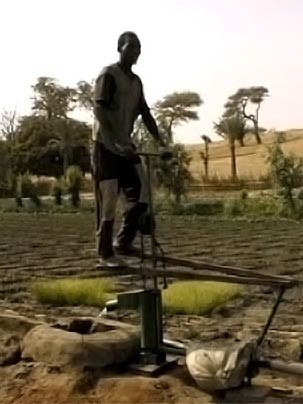In The World is a new column that explores the ways people from MIT are using technology--from the appropriately simple to the cutting-edge--to help meet the needs of local people in places around the planet. If you know of a good example and would like the News Office to write about it, please e-mail dlc1@mit.edu.
The parched landscape of Sudan, on the southern edge of the Sahara desert, is among the world's driest regions, with a nine-month dry season and a highly unreliable rainy season. Large-scale farmers there manage to grow about half of the impoverished nation's food production with the help of motorized irrigation pumps, but for individual subsistence farmers and their families--about two-thirds of the nation's 40 million people--growing crops mostly means hauling water by hand in buckets.
That's a method that's inefficient and unreliable, often leading to crop failures that add to Sudan's burden of malnutrition and poverty. But thanks to a new venture set up by two MIT students, with a little bit of help from small grants from the MIT Public Service Center and Legatum Center, some of those farmers will soon get a chance to improve their crops, their livelihoods and the health of their families.
Mustafa Dafalla, a third-year student in civil and environmental engineering whose parents come from Sudan and who has visited there often, and Zahir Dossa, a fourth-year student at MIT Sloan School of Management, have created a new nonprofit organization called Selsabila to bring a simple technological solution to the region: Inexpensive treadle-powered water pumps, developed and produced by a company in India.
"There are plenty of programs in place to help large farmers," Dafalla says, "but nothing for low-income farmers."
The students began the project during last year's IAP, when they traveled to Sudan to find local supervisors and managers for the project, and to India to test the pumps and make arrangements with the manufacturer. After working over the course of the year to set up their company and finalize their plans, this month they will be visiting villages to promote the pumps and take orders. They aim to get the first 100 or more of the $100 pumps into the hands of Sudanese farmers by this May, with the help of local microfinance institutions in that country.
The pumps are expected to pay for themselves within the first year, through increased output--they should triple the average farmer's food production. At the same time, the venture will create new local businesses in the nation, as they set up stores to sell and service the pumps in local marketplaces.
Ultimately, Dossa and Dafalla hope to turn over the whole company to local people, where it would provide a source of revenue to help the struggling country's economy.
The organization's name, Selsabila, comes from the Koran, Dafalla explains. It means "a river that springs forth in heaven" he says. "It's an upbeat name--when people hear it, they would think of flowing water. A lot of these farmers are in despair, and we want to make people feel hope."
A version of this article appeared in MIT Tech Talk on January 30, 2008 (download PDF).






